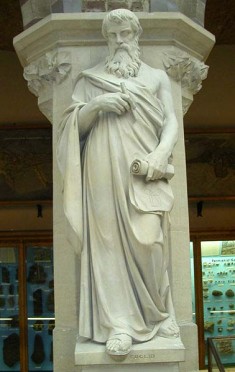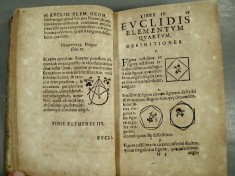| Euclid | |
|---|---|
 |
|
| Mathematician | |
| Specialty | Euclidean geometry |
| Nationality | Greek |
Euclid, an ancient Greek mathematician, is often referred to as “the Father of Geometry.” This is a name that looms large in the history of mathematics and throughout the field of science. But there is some speculation about if this man really existed. Some scholars have argued that Euclid is — if not exactly a mythical figure — more likely a name given to a group, school, or tradition of ancient mathematicians who developed the fundamentals of geometry.
Euclid’s Potential Beginnings
It was somewhat common for the highly accomplished mathematicians of ancient Greece to leave behind biographies of their lives and works, yet none exist for a man named Euclid. There are a few scattered references to a man named Euclid in other texts, however. This suggests he may have actually lived and worked in Egypt the time of the reign of Ptolemy I.
Ptolemy was a Greek who ruled Egypt from 367 B.C. to about 283 B.C., and so this is often given as the time period of Euclid. No records of the birth or death of Euclid exist. Some give the date of Euclid’s birth at 325 B.C.
Many of the references to Euclid are highly problematic. For example, one of our primary sources of information about Euclid comes from the works of Proclus — but he lived some 500 to 700 years after the time of Euclid.
Euclid’s Work
The major work ascribed to Euclid is Elements. This is a series of 13 books which contain the basis for Euclidean Geometry. Elements describes axioms, theorems, and constructions — what they are, how they work, and how to use them. It also provides mathematical proofs for all of the above definitions.
Also outlined is the number theory of the ancient Greeks, as well as geometric algebra. This latter system is comprehensive enough to solve basic algebra problems, including how to find the square roots of numbers.
The accomplishments that come out of Elements are astonishing. For example, in these works we find the first presentation and explanation of an Axiomatic System. An Axiomatic system is any set of axioms (postulates or premises) from which all axioms can be used to derive theorems using logic. All theories of math use an axiomatic system.
Euclid’s Other Works
In addition to the 13 books of the Elements, there are five other works which have survived to modern times and are ascribed to Euclid as the author. Among these is a book called Optics. This work was concerned with how the human eye perceives the outside world. It suggests that eyesight is made possible by “rays” which shoot out or “emanate” from human eyes.
 More importantly is one of the definitions that came out of Optics. It says that when we see objects from a greater angle, those objects appear greater, and that when we see object from a lesser angle, they appear to be lesser. And finally, when we see things from equal angles, they appear equal.
More importantly is one of the definitions that came out of Optics. It says that when we see objects from a greater angle, those objects appear greater, and that when we see object from a lesser angle, they appear to be lesser. And finally, when we see things from equal angles, they appear equal.
These fundamental aspects of examining the nature of vision and how we perceive angles is taken for granted today, but in ancient times little of this was understood. For Euclid to nail down these basics meant that people could not only begin to make accurate measurements, but they could also manipulate this “data” with well-developed mathematical formulas that were universal and reliable.
Even the subject of “data” itself at one time had no proper or universal definition, which is difficult for us to imagine today. However, it was Euclid’s book, Data, which defined the meaning of having “given information” that was reliable and could be applied to problems of math and practical applications.
Euclidean Controversy
The 13 books of the Elements and the five other existing books ascribed to Euclid would mean that, if written by a single individual, Euclid would have been one of the most brilliant men in all of history.
Thus, it is tempting to suggest that his extraordinary body of work is actually the combined labor of many brilliant mathematicians. It may be the case that Euclid was one among many, or perhaps the primary individual behind the development of modern geometry.